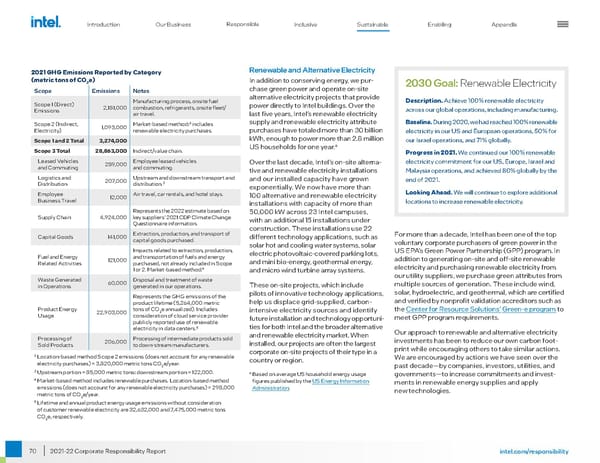70 intel.com/responsibility 2021-22 Corporate Responsibility Report 2021 GHG Emissions Reported by Category (metric tons of CO 2 e) Scope Emissions Notes Scope 1 (Direct) Emissions 2,181,000 Manufacturing process, onsite fuel combustion, refrigerants, onsite fleet/ air travel. Scope 2 (Indirect, Electricity) 1,093,000 Market-based method; 2 includes renewable electricity purchases. Scope 1 and 2 Total 3,274,000 Scope 3 Total 28,863,000 Indirect/value chain. Leased Vehicles and Commuting 289,000 Employee leased vehicles and commuting. Logistics and Distribution 207,000 Upstream and downstream transport and distribution. 3 Employee Business Travel 12,000 Air travel, car rentals, and hotel stays. Supply Chain 4,924,000 Represents the 2022 estimate based on key suppliers’ 2021 CDP Climate Change Questionnaire information. Capital Goods 141,000 Extraction, production, and transport of capital goods purchased. Fuel and Energy Related Activities 121,000 Impacts related to extraction, production, and transportation of fuels and energy purchased, not already included in Scope 1 or 2. Market-based method. 4 Waste Generated in Operations 60,000 Disposal and treatment of waste generated in our operations. Product Energy Usage 22,903,000 Represents the GHG emissions of the product lifetime (5,264,000 metric tons of CO 2 e annualized). Includes consideration of cloud service provider publicly reported use of renewable electricity in data centers. 5 Processing of Sold Products 206,000 Processing of intermediate products sold to down-stream manufacturers. 2 Location-based method Scope 2 emissions (does not account for any renewable electricity purchases) = 3,820,000 metric tons CO 2 e/year. 3 Upstream portion = 85,000 metric tons; downstream portion = 122,000. 4 Market-based method includes renewable purchases. Location-based method emissions (does not account for any renewable electricity purchases) = 298,000 metric tons of CO 2 e/year. 5 Lifetime and annual product energy usage emissions without consideration of customer renewable electricity are 32,632,000 and 7,475,000 metric tons CO 2 e, respectively. Renewable and Alternative Electricity In addition to conserving energy, we pur - chase green power and operate on-site alternative electricity projects that provide power directly to Intel buildings. Over the last five years, Intel’s renewable electricity supply and renewable electricity attribute purchases have totaled more than 30 billion kWh, enough to power more than 2.8 million US households for one year. 6 Over the last decade, Intel’s on-site alterna - tive and renewable electricity installations and our installed capacity have grown exponentially. We now have more than 100 alternative and renewable electricity installations with capacity of more than 50,000 kW across 23 Intel campuses, with an additional 15 installations under construction. These installations use 22 different technology applications, such as solar hot and cooling water systems, solar electric photovoltaic-covered parking lots, and mini bio-energy, geothermal energy, and micro wind turbine array systems. These on-site projects, which include pilots of innovative technology applications, help us displace grid-supplied, carbon- intensive electricity sources and identify future installation and technology opportuni - ties for both Intel and the broader alternative and renewable electricity market. When installed, our projects are often the largest corporate on-site projects of their type in a country or region. 6 Based on average US household energy usage figures published by the US Energy Information Administration . 2030 Goal: Renewable Electricity Description. Achieve 100% renewable electricity across our global operations, including manufacturing. Baseline. During 2020, we had reached 100% renewable electricity in our US and European operations, 50% for our Israel operations, and 71% globally. Progress in 2021. We continued our 100% renewable electricity commitment for our US, Europe, Israel and Malaysia operations, and achieved 80% globally by the end of 2021. Looking Ahead. We will continue to explore additional locations to increase renewable electricity. For more than a decade, Intel has been one of the top voluntary corporate purchasers of green power in the US EPA’s Green Power Partnership (GPP) program. In addition to generating on-site and off-site renewable electricity and purchasing renewable electricity from our utility suppliers, we purchase green attributes from multiple sources of generation. These include wind, solar, hydroelectric, and geothermal, which are certified and verified by nonprofit validation accreditors such as the Center for Resource Solutions’ Green-e program to meet GPP program requirements. Our approach to renewable and alternative electricity investments has been to reduce our own carbon foot - print while encouraging others to take similar actions. We are encouraged by actions we have seen over the past decade—by companies, investors, utilities, and governments—to increase commitments and invest - ments in renewable energy supplies and apply new technologies. Introduction Our Business Responsible Inclusive Sustainable Enabling Appendix
 Intel Corporate Responsibility Report Page 69 Page 71
Intel Corporate Responsibility Report Page 69 Page 71